When jumping, as with the true meaning of dressage, it is important to know the aim of each jump. Jumps all have different functions and they can be used to improve a horse’s confidence and way of going. A cross pole is a jump shaped like an X, commonly used to introduce jumping to horses after a period of pole work over single poles on the ground. The cross pole provides an invitation to travel over the center of the jump, instead of drifting over to the left or right of the jump. The higher the cross pole becomes, the more the horse has to bounce and round over the jump in order to snap their legs out of the way. This is an excellent jump to use for inexperienced, as well as experienced horses, as it can provide various degrees of difficulty depending on its height and placement within a grid of jumps. When the jump is raised more, remember to provide the horse with a ground line, so that they can bascule nicely over the obstacle by knowing exactly when to take off. Getting too deep into a big cross pole can be very detrimental to both the horse and the rider’s confidence.
Raising one side of a cross pole while still riding a horse through the center of the jump, can also prove invaluable in assisting horses with a “lazy leg” to snap up that leg neatly. Another advanced function of this exercise could be to assist a horse to land on the correct lead. If the horse struggles to take off and land on the right lead for example, the rider can raise the right bar of the cross and ask the horse to jump the cross on a circle to the right. The raised bar on the inside of the circle encourages the horse to lift his right fore up slightly before the left fore. As a result, they tend to hover in the air a bit longer with this leg, as well as the right hind, ultimately helping them to land on the right lead in the canter.
Uprights are explained quite well in the above video. They provide a solid, difficult fence for horse and rider to tackle, depending on their placement in the arena, their steepness (lack of ground line) and the angle at which they are approached.
Oxers come in various forms and each type provides the horse and rider with a different challenge. Square oxers demand of the horse to pay close attention to the rider’s aids, as well as their approach to the jump. They should be jumped with plenty of power and impulsion and the rider should take care not to sit up too soon in the moment of suspension, otherwise the horse may knock the back rail with his hind feet. Ascending oxers are wonderful tools to help horses make a good shape (bascule) over the jump. The raised back rail encourages the horse to snap up his hind legs in order to clear the jump well – in this way, the jump can be used to improve a horse’s jumping style. Descending oxers are visually difficult for the horse and should only be attempted by very experienced riders. Even then, a basic “V” of poles placed on the take-off side of a vertical/upright, is much safer and more effective at asking the horse to snap up his front legs than a descending oxer is.


